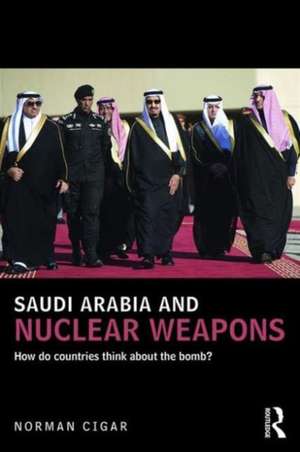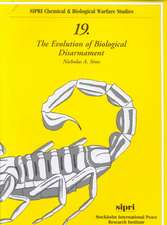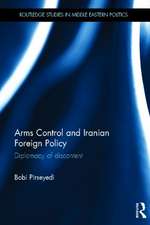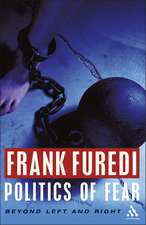Saudi Arabia and Nuclear Weapons: How do countries think about the bomb?: UCLA Center for Middle East Development (CMED)
Autor Norman Cigaren Limba Engleză Paperback – 21 mar 2016
Saudi Arabia and Nuclear Weapons uses an "inside out" approach that emphasises the Saudis’ own national interests in relation to the nuclear threat, and their understanding of the role of nuclear weapons in defense, foreign policy and the concept of deterrence. It is the first study with comprehensive use of the local Arabic language military and civilian media to provide this understanding of official thinking and policy. The Saudi case study is contextualised against the prevailing proliferation models, to conclude that the Saudi case shares both commonalities and elements of uniqueness with other proliferation cases, implying the need for a ‘multi-causal’ approach. Its comparative analysis also suggests potential implications applicable more broadly to the issue of nuclear proliferation.
A comprehensive study of Saudi Arabia’s attitude to nuclear weapons, this book offers an exploration of nuclear proliferation that would interest students, scholars and policymakers working in Middle East studies, as well as Military and nuclear proliferation studies.
| Toate formatele și edițiile | Preț | Express |
|---|---|---|
| Paperback (1) | 413.94 lei 6-8 săpt. | |
| Taylor & Francis – 21 mar 2016 | 413.94 lei 6-8 săpt. | |
| Hardback (1) | 820.71 lei 6-8 săpt. | |
| Taylor & Francis – apr 2016 | 820.71 lei 6-8 săpt. |
Din seria UCLA Center for Middle East Development (CMED)
-
 Preț: 392.87 lei
Preț: 392.87 lei -
 Preț: 305.85 lei
Preț: 305.85 lei -
 Preț: 431.35 lei
Preț: 431.35 lei -
 Preț: 488.71 lei
Preț: 488.71 lei -
 Preț: 416.26 lei
Preț: 416.26 lei - 15%
 Preț: 426.20 lei
Preț: 426.20 lei - 15%
 Preț: 698.17 lei
Preț: 698.17 lei -
 Preț: 489.26 lei
Preț: 489.26 lei -
 Preț: 443.78 lei
Preț: 443.78 lei -
 Preț: 413.33 lei
Preț: 413.33 lei - 26%
 Preț: 819.90 lei
Preț: 819.90 lei -
 Preț: 418.13 lei
Preț: 418.13 lei - 13%
 Preț: 337.39 lei
Preț: 337.39 lei -
 Preț: 415.24 lei
Preț: 415.24 lei -
 Preț: 369.43 lei
Preț: 369.43 lei -
 Preț: 360.43 lei
Preț: 360.43 lei -
 Preț: 363.53 lei
Preț: 363.53 lei -
 Preț: 366.68 lei
Preț: 366.68 lei -
 Preț: 366.47 lei
Preț: 366.47 lei -
 Preț: 387.42 lei
Preț: 387.42 lei -
 Preț: 385.08 lei
Preț: 385.08 lei
Preț: 413.94 lei
Nou
Puncte Express: 621
Preț estimativ în valută:
79.22€ • 82.40$ • 65.40£
79.22€ • 82.40$ • 65.40£
Carte tipărită la comandă
Livrare economică 14-28 aprilie
Preluare comenzi: 021 569.72.76
Specificații
ISBN-13: 9781138643307
ISBN-10: 1138643300
Pagini: 248
Dimensiuni: 156 x 234 x 23 mm
Greutate: 0.4 kg
Ediția:1
Editura: Taylor & Francis
Colecția Routledge
Seria UCLA Center for Middle East Development (CMED)
Locul publicării:Oxford, United Kingdom
ISBN-10: 1138643300
Pagini: 248
Dimensiuni: 156 x 234 x 23 mm
Greutate: 0.4 kg
Ediția:1
Editura: Taylor & Francis
Colecția Routledge
Seria UCLA Center for Middle East Development (CMED)
Locul publicării:Oxford, United Kingdom
Public țintă
Postgraduate and UndergraduateCuprins
Chapter 1: Introduction Chapter 2: The Dynamics of Saudi Strategic Culture and the Decision-making Process Chapter 3: Developing Nuclear Threat Assessments Chapter 4: Analyzing the Threat in Riyadh: Why Would a Nuclear Iran Be So Dangerous? Chapter 5: Thinking in Terms of Solutions – How to Stop Iran Chapter 6: Thinking in Terms of Solutions-- the Evolution in Saudi Thinking toward a Nuclear Option Chapter 7: Thinking about the utility of Nuclear weapons: deterrence and Beyond Chapter 8: Where Does the Civilian Nuclear Power Sector Fit In? Chapter 9: The Religious Sector-- Legitimization and Accountability Chapter 10: A Nuclear Environment and Foreign Policy: Reshaping Relations within the Gulf Chapter 11: The Rouhani Era in Tehran and a new age of anxiety in Riyadh Chapter 12: Coming to terms with the 14 July 2015 Nuclear Agreement: Saudi Anxiety overcome? Chapter 13: Conclusions and Implications
Descriere
Saudi Arabia and Nuclear Weapons uses an "inside out" approach that emphasises the Saudis’ own national interests in relation to the nuclear threat, and their understanding of the role of nuclear weapons in defense, foreign policy and the concept of deterrence. It is the first study with comprehensive use of the local Arabic language military and civilian media to provide this understanding of official thinking and policy. The Saudi case study is contextualised against the prevailing proliferation models, to conclude that the Saudi case shares both commonalities and elements of uniqueness with other proliferation cases, implying the need for a ‘multi-causal’ approach. Its comparative analysis also suggests potential implications applicable more broadly to the issue of nuclear proliferation.
















